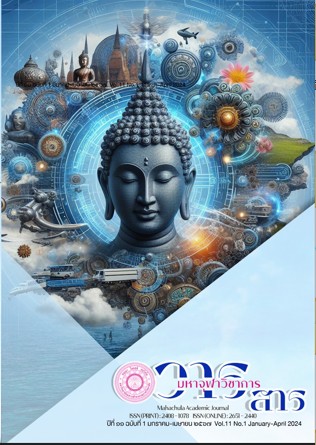The Effects of Organizing Learning Activities Using IMPROVE Method With Think-Pair-Square Technique on Mathematical Problem Solving And Communication Abilities of Mathayomsuksa 2 Students
Main Article Content
Abstract
The purposes of this research were; 1) to compare mathematical problem solving ability of Mathayomsuksa II students after learning with IMPROVE method with Think-Pair-Square technique activity as compare with the criterion of 70% and; 2) to compare mathematical communication ability of Mathayomsuksa II students after learning with IMPROVE method with Think-Pair-Square technique activity as compare with the criterion of 70%.The sample were 36 Mathayomsuksa II students of the second semester in academic year B.E 2565 they were selected by cluster random sampling method. The research instruments used in this research consisted of; 1) four lesson plans on surface area and volume using IMPROVE method with Think-Pair-Square technique activity, 2) Mathematical problem solving and communication abilities test, with the reliability of 0.81. The statistical for analyzing the collected data were mean, standard deviation and t-test for one sample.
The results of the study were as follows: (1) .Mathematical problem solving ability of Mathayomsuksa II students after learning with with IMPROVE method with Think-Pair-Square technique activities was higher than the set criterion of 70% at 0.05 level of statistical significance. (2) Mathematical communication ability of Mathayomsuksa II students after learning with with IMPROVE method with Think-Pair-Square technique activities was higher than the set criterion of 70% at 0.05 level of statistical significance.
Article Details

This work is licensed under a Creative Commons Attribution-NonCommercial-NoDerivatives 4.0 International License.
References
กระทรวงศึกษาธิการ. หลักสูตรการศึกษาขั้นพื้นฐาน พุทธศักราช ๒๕๔๕. กรุงเทพมหานคร: องค์การรับส่งสินค้าและภัสดุภัณฑ์ (ร.ส.พ.), ๒๕๔๕.
วรรณิภา เรียบเรียง. “การศึกษาความสามารถในการแก้ปัญหาและการให้เหตุผลทางคณิตศาสตร์ เรื่อง ความน่าจะเป็นของนักเรียนชั้นมัธยมศึกษาปีที่ ๓ โดยใช้การจัดการเรียนรู้ตามวิธี IMPROVE”. วารสาร มทร.อีสาน ฉบับมนุษยศาสตร์และสังคมศาสตร์. ปีที่ ๕ ฉบับที่ ๒ (กรกฎาคม-ธันวาคม ๒๕๖๑): ๗๒-๘๕.
เวชฤทธิ์ อังกนะภัทรขจร. ครบเครื่องเรื่องควรรู้สำหรับครูคณิตศาสตร์: หลักสูตร การสอนและการวิจัย. กรุงเทพมหานคร: จรัลสนิทวงศ์การพิมพ์, ๒๕๕๕.
สถาบันส่งเสริมการสอนวิทยาศาสตร์และเทคโนโลยี. ทักษะ/กระบวนการทางคณิตศาสตร์มืออาชีพ. กรุงเทพมหานคร: ส.เจริญการพิมพ์, ๒๕๕๑.
___________. การวัดผลประเมินผลคณิตศาสตร์. กรุงเทพมหานคร: ซีเอ็ดยูเคชั่น, ๒๕๕๕.
___________. สรุปผลการประเมิน PISA ๒๐๒๒ .กรุงเทพมหานคร: กระทรวงศึกษาธิการ, ๒๕๖๖.
___________. ทักษะและกระบวนการทางคณิตศาสตร์. กรุงเทพมหานคร: ๓-คิว มีเดีย, ๒๕๕๕.
สัมภาษณ์ นลินญา บุญเต็ม, ครูชำนาญการพิเศษ โรงเรียนแสนสุข จังหวัดชลบุรี, ๑๘ พฤศจิกายน ๒๕๖๔.
สิริพร ทิพย์คง. การแก้ปัญหาคณิตศาสตร์. กรุงเทพมหานคร: โรงพิมพ์คุรุสภาลาดพร้าว, ๒๕๔๔.
อัมพร ม้าคนอง. ทักษะและกระบวนการทางคณิตศาสตร์ : การพัฒนาเพื่อพัฒนาการ. กรุงเทพมหานคร: ศูนย์ตำราและเอกสารทางวิชาการ คณะครุศาสตร์ จุฬาลงกรณ์มหาวิทยาลัย, ๒๕๕๓.
Atkinson; R.C.; & Shiffrin, R.M. Human Memory : A Proposed System and Its Control Processes. The Psychology of Learning and Motivation: Advanced in Research and Theory. New York: Academic, 1968.
Hermiatis. “The Effectiveness of Think-Pair-Square (TPS) Strategy in Teaching Students' Listenning Comprehension at the Second Grade in SMA Negeri 3 sidrap”. bachelor of education Degree. Tarbiyah and Teaching Science Faculty: Alauddin State Isalamic University of Makassar, 2017.
Mawaddah. “The Effect of Type Cooperrative learning model Think Pair Square on learning outcomes Geography of class x students of SMA Negeri 1 Tangerang south”. Bachelor of Education Degree . Faculty of Tarbiyah and Teacher Training: University Islam Negeri, 2020.
Mevarech, Z. R. and Kramarski, B. “Improve: A multidimensional method for teaching mathematics in heterogeneous classrooms”. American Educational Research Journal. vol. 34 No. 2 (Summer 1997): 365-394.
Millis, Barbara J. and Philip Cottell G. Cooperative Learning for Higher Education Faculty. Phoenix: Oryx Press, 1998.
Mumme, J., & Shepherd, N.. Communication in mathematics. In Implementing the K-8 curriculum and evaluation standard. Virginia: NCTM, 1993.
Rowan, Thomas E.; & Morrow, Lorna J. Implementing k-8 curriculum and evaluation standards: reading from the arithmetic teacher. Virginia: The National Council of Teachers of Mathematics, 1993.
U. Erra and G. Scanniello. “Assessing think-pair-square in distributed modeling of use case diagrams”. Department of Mathematics and computer Science: University of Basilicata, 2019.
Warno Edi. “Effectiveness of think-pair-square strategy on students’ reading comprehension”. Journal anglo-saxon. vol. 7 No. 1 (2016): 32-40.


